Spatially Broadband Coupled-Surface Plasmon Wave Assisted Transmission Effect in Azo-Dye-Doped Liquid Crystal Cell
Abstract
1. Introduction
2. Materials and Methods
2.1. Sample Preparation
2.2. Measurements
3. Results and Discussion
4. Conclusions
Author Contributions
Funding
Conflicts of Interest
References
- Ebbesen, T.W.; Lezec, H.J.; Ghaemi, H.F.; Thio, T.; Wolff, P.A. Extraordinary optical transmission through sub-wavelength hole arrays. Nature 1998, 391, 667–669. [Google Scholar] [CrossRef]
- Martín-Moreno, L.; García-Vidal, F.J.; Lezec, H.J.; Pellerin, K.M.; Thio, T.; Pendry, J.B.; Ebbesen, T.W. Theory of Extraordinary Optical Transmission through Subwavelength Hole Arrays. Phys. Rev. Lett. 2001, 86, 1114–1117. [Google Scholar] [CrossRef]
- Kravets, V.G.; Kabashin, A.V.; Barnes, W.L.; Grigorenko, A.N. Plasmonic Surface Lattice Resonances: A Review of Properties and Applications. Chem. Rev. 2018, 118, 5912–5951. [Google Scholar] [CrossRef]
- Zheludev, N.I. The Road Ahead for Metamaterials. Science 2010, 328, 582–583. [Google Scholar] [CrossRef] [PubMed]
- Khorasaninejad, M.; Chen, W.T.; Devlin, R.C.; Oh, J.; Zhu, A.Y.; Capasso, F. Metalenses at visible wavelengths: Diffraction-limited focusing and subwavelength resolution imaging. Science 2016, 352, 1190. [Google Scholar] [CrossRef]
- Chen, W.T.; Zhu, A.Y.; Sisler, J.; Bharwani, Z.; Capasso, F. A broadband achromatic polarization-insensitive metalens consisting of anisotropic nanostructures. Nat. Commun. 2019, 10, 355. [Google Scholar] [CrossRef] [PubMed]
- Su, V.C.; Chu, C.H.; Sun, G.; Tsai, D.P. Advances in optical metasurfaces: Fabrication and applications. Opt. Express 2018, 26, 13148–13182. [Google Scholar] [CrossRef]
- Kildishev, A.V.; Boltasseva, A.; Shalaev, V.M. Planar Photonics with Metasurfaces. Science 2013, 339, 1232009. [Google Scholar] [CrossRef] [PubMed]
- Lu, D.; Liu, Z. Hyperlenses and metalenses for far-field super-resolution imaging. Nat. Commun. 2012, 3, 1205. [Google Scholar] [CrossRef]
- Guo, Y.; Jacob, Z. Thermal hyperbolic metamaterials. Opt. Express. 2013, 21, 15014–15019. [Google Scholar] [CrossRef]
- Jahani, S.; Jacob, Z. All-dielectric metamaterials. Nat. Nanotechnol. 2016, 11, 23. [Google Scholar] [CrossRef] [PubMed]
- Olson, J.; Manjavacas, A.; Basu, T.; Huang, D.; Schlather, A.E.; Zheng, B.; Halas, N.J.; Nordlander, P.; Link, S. High Chromaticity Aluminum Plasmonic Pixels for Active Liquid Crystal Displays. ACS Nano 2016, 10, 1108–1117. [Google Scholar] [CrossRef] [PubMed]
- Bartholomew, R.; Williams, C.; Khan, A.; Bowman, R.; Wilkinson, T. Plasmonic nanohole electrodes for active color tunable liquid crystal transmissive pixels. Opt. Lett. 2017, 42, 2810–2813. [Google Scholar] [CrossRef]
- Yen, Y.R.; Lee, T.H.; Wu, Z.Y.; Lin, T.H.; Hung, Y.J. Comprehensive three-dimensional analysis of surface plasmon polariton modes at uniaxial liquid crystal-metal interface. Opt. Express 2015, 23, 32377–32386. [Google Scholar] [CrossRef]
- Ryu, S.H.; Yoon, D.K. Switchable Plasmonic Film Using Nanoconfined Liquid Crystals. ACS Appl. Mater. Interfaces 2017, 9, 25057–25061. [Google Scholar] [CrossRef]
- Dickson, W.; Wurtz, G.A.; Evans, P.R.; Pollard, R.J.; Zayats, A.V. Electronically Controlled Surface Plasmon Dispersion and Optical Transmission through Metallic Hole Arrays Using Liquid Crystal. Nano Lett. 2008, 8, 281–286. [Google Scholar] [CrossRef]
- Liu, Y.J.; Zheng, Y.B.; Liou, J.; Chiang, I.K.; Khoo, I.C.; Huang, T.J. All-Optical Modulation of Localized Surface Plasmon Coupling in a Hybrid System Composed of Photoswitchable Gratings and Au Nanodisk Arrays. J. Phys. Chem. C 2011, 115, 7717. [Google Scholar] [CrossRef]
- Mbarak, H.; Ghahrizjani, R.T.; Hamidi, S.M.; Mohajerani, E.; Zaatar, Y. Reversible and tunable photochemical switch based on plasmonic structure. Sci. Rep. 2020, 10, 5110. [Google Scholar] [CrossRef]
- Xiong, K.; Tordera, D.; Emilsson, G.; Olsson, O.; Linderhed, U.; Jonsson, M.P.; Dahlin, A.B. Switchable Plasmonic Metasurfaces with High Chromaticity Containing Only Abundant Metals. Nano Lett. 2017, 17, 7033–7039. [Google Scholar] [CrossRef]
- Misbah, I.; Zhao, F.; Shih, W.-C. Symmetry Breaking-Induced Plasmonic Mode Splitting in Coupled Gold–Silver Alloy Nanodisk Array for Ultrasensitive RGB Colorimetric Biosensing. ACS Appl. Mater. Interfaces 2019, 11, 2273–2281. [Google Scholar] [CrossRef] [PubMed]
- Pan, M.Y.; Li, Q.; Hong, Y.; Cai, L.; Lu, J.; Qiu, M. Circular-polarization-sensitive absorption in refractory metamaterials composed of molybdenum zigzag arrays. Opt. Express 2018, 26, 17772–17780. [Google Scholar] [CrossRef] [PubMed]
- Lee, D.; Han, S.Y.; Jeong, Y.; Nguyen, D.M.; Yoon, G.; Mun, J.; Chae, J.; Lee, J.H.; Ok, J.G.; Jung, G.Y.; et al. Polarization-sensitive tunable absorber in visible and near-infrared regimes. Sci. Rep. 2018, 8, 12393. [Google Scholar] [CrossRef] [PubMed]
- Gilardi, G.; Xiao, S.; Asger, M.N.; d’Alessandro, A.; Beccherelli, R. Plasmon resonance optical tuning based on photosensitive composite structures. JOSA B 2014, 31, 360–365. [Google Scholar] [CrossRef][Green Version]
- Franklin, D.; Chen, Y.; Vazquez, G.A.; Modak, S.; Boroumand, J.; Xu, D.; Wu, S.T.; Chanda, D. Polarization-independent actively tunable colour generation on imprinted plasmonic surfaces. Nat. Commun. 2015, 6, 7337. [Google Scholar] [CrossRef] [PubMed]
- Lee, J.Y.; Hung, Y.J. Band diagrams and field distribution of squarely-modulated slab metallic gratings. AIP Adv. 2016, 6, 125117. [Google Scholar] [CrossRef]
- Knight, M.W.; King, N.S.; Liu, L.; Everitt, H.O.; Nordlander, P.; Halas, N.J. Aluminum for Plasmonics. ACS Nano 2014, 8, 834–840. [Google Scholar] [CrossRef]
- Clark, B.D.; Jacobson, C.R.; Lou, M.; Renard, D.; Wu, G.; Bursi, L.; Ali, A.S.; Swearer, D.F.; Tsai, A.L.; Nordlander, P.; et al. Aluminum Nanocubes Have Sharp Corners. ACS Nano 2019, 13, 9682–9691. [Google Scholar] [CrossRef]
- Rezaei, S.D.; Hong Ng, R.J.; Dong, Z.; Ho, J.; Koay, E.H.H.; Ramakrishna, S.; Yang, J.K.W. Wide-Gamut Plasmonic Color Palettes with Constant Subwavelength Resolution. ACS Nano 2019, 13, 3580–3588. [Google Scholar] [CrossRef]
- Cheng, C.W.; Liao, Y.J.; Liu, C.Y.; Wu, B.H.; Raja, S.S.; Wang, C.Y.; Li, X.; Shih, C.K.; Chen, L.J.; Gwo, S. Epitaxial Aluminum-on-Sapphire Films as a Plasmonic Material Platform for Ultraviolet and Full Visible Spectral Regions. ACS Photonics 2018, 5, 2624–2630. [Google Scholar] [CrossRef]
- Huang, C.Y.; Lin, Y.R.; Lo, K.Y.; Lee, C.R. Dynamics of photoalignment in azo-dye-doped liquid crystals. App. Phys. Lett. 2008, 93, 181114. [Google Scholar] [CrossRef]
- Fuh, A.Y.G.; Li, M.H.; Chang, T.W.; Lee, Y.I.; Wu, S.T. Optical manipulation of nematic colloids at the interfaces in azo-dye-doped liquid crystals. Appl. Opt. 2018, 57, 3180–3185. [Google Scholar] [CrossRef] [PubMed]
- Fan, X.; Zheng, W.; Singh, D.J. Light scattering and surface plasmons on small spherical particles. Light Sci. Appl. 2014, 3, e179. [Google Scholar] [CrossRef]
- Tabiryan, N.; Hrozhyk, U.; Serak, S. Nonlinear Refraction in Photoinduced Isotropic State of Liquid Crystalline Azobenzenes. Phys. Rev. Lett. 2004, 93, 113901. [Google Scholar] [CrossRef]
- Hrozhyk, U.A.; Serak, S.V.; Tabiryan, N.V.; Bunning, T.J. Optical Tuning of the Reflection of Cholesterics Doped with Azobenzene Liquid Crystals. Adv. Funct. Mater. 2007, 17, 1735–1742. [Google Scholar] [CrossRef]
- Audia, B.; Pagliusi, P.; Provenzano, C.; Roche, A.; Oriol, L.; Cipparrone, G. Influence of Photoanisotropies on Light-Controllable Structuration of Azopolymer Surface. ACS Appl. Polym. Mater. 2020, 2, 1597–1604. [Google Scholar] [CrossRef]
- Chang, V.Y.; Fedele, C.; Priimagi, A.; Shishido, A.; Barrett, C.J. Photoreversible Soft Azo Dye Materials: Toward Optical Control of Bio-Interfaces. Adv. Opt. Mater. 2019, 7, 1900091. [Google Scholar] [CrossRef]
- Zeng, S.; Baillargeat, D.; Ho, H.P.; Yong, K.T. Nanomaterials enhanced surface plasmon resonance for biological and chemical sensing applications. Chem. Soc. Rev. 2014, 43, 3426. [Google Scholar] [CrossRef]
- Jau, H.C.; Chou, P.C.; Chen, C.W.; Li, C.C.; Leng, S.E.; Lee, C.H.; Lin, T.H. All-optical control of polarization splitting with a dielectric-clad azobenzene liquid crystal. Opt. Express 2018, 26, 781–789. [Google Scholar] [CrossRef]
- Scott, P. Mie Scattering Calculator 2018. Available online: https://omlc.org/calc/mie_calc.html (accessed on 8 April 2019).
- Rakić, A.D. Algorithm for the determination of intrinsic optical constants of metal films: Application to aluminum. Appl. Opt. 1995, 34, 4755–4767. [Google Scholar] [CrossRef]
- Rakić, A.D.; Djurišic, A.B.; Elazar, J.M.; Majewski, M.L. Optical properties of metallic films for vertical-cavity optoelectronic devices. Appl. Opt. 1998, 37, 5271–5283. [Google Scholar] [CrossRef]
- McPeak, K.M.; Jayanti, S.V.; Kress, S.J.P.; Meyer, S.; Iotti, S.; Rossinelli, A.; Norris, D.J. Plasmonic films can easily be better: Rules and recipes. ACS Photonics 2015, 2, 326–333. [Google Scholar] [CrossRef] [PubMed]
- Johnson, P.B.; Christy, R.W. Optical constants of transition metals: Ti, V, Cr, Mn, Fe, Co, Ni, and Pd. Phys. Rev. B 1974, 9, 5056–5070. [Google Scholar] [CrossRef]
- Werner, W.S.M.; Glantschnig, K.; Ambrosch, D.C. Optical constants and inelastic electron-scattering data for 17 elemental metals. J. Phys. Chem. Ref. Data 2009, 38, 1013–1092. [Google Scholar] [CrossRef]
- Polyanskiy, M. Refractive Index Info 2008. Available online: https://refractiveindex.info/ (accessed on 10 April 2019).

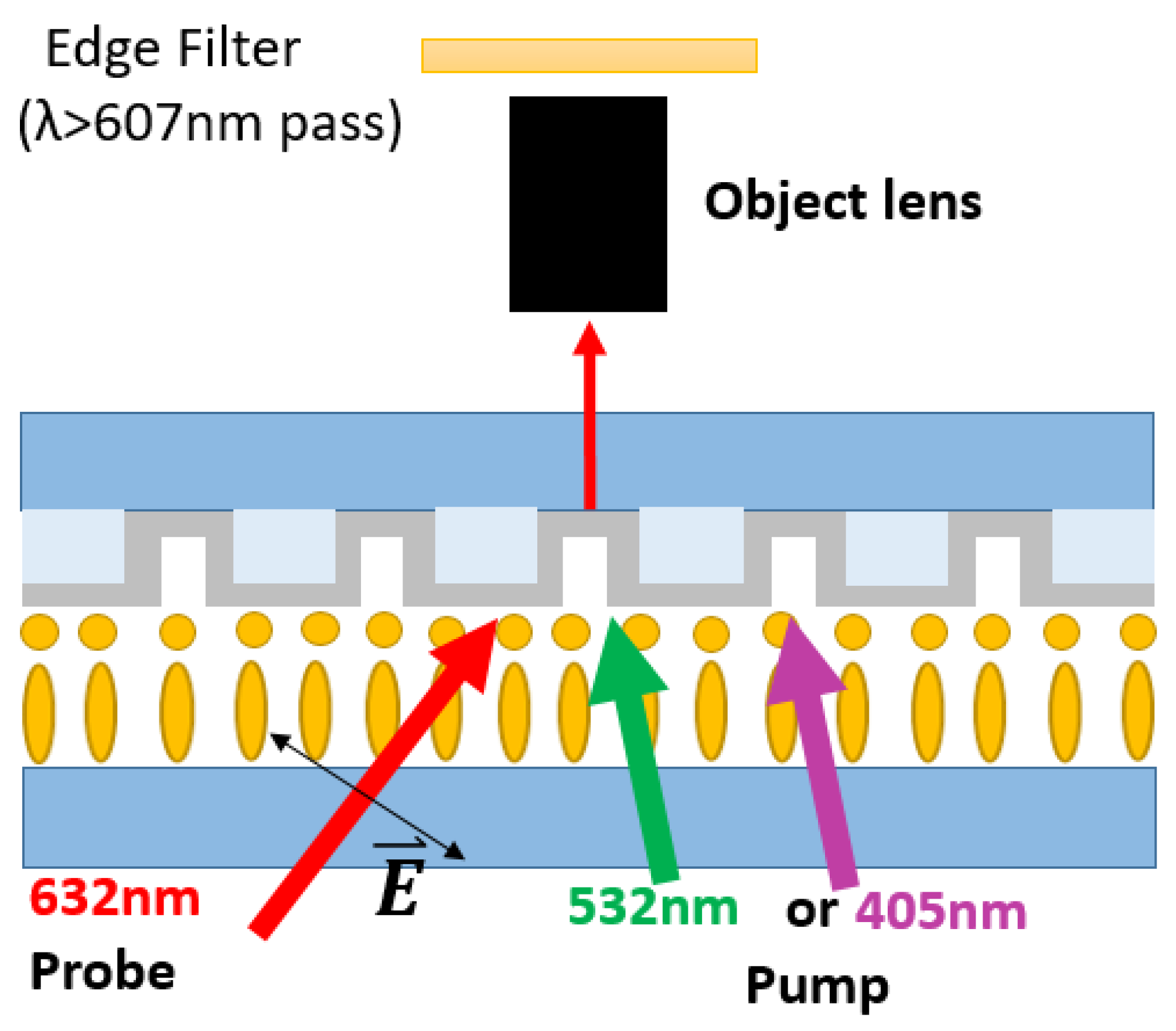
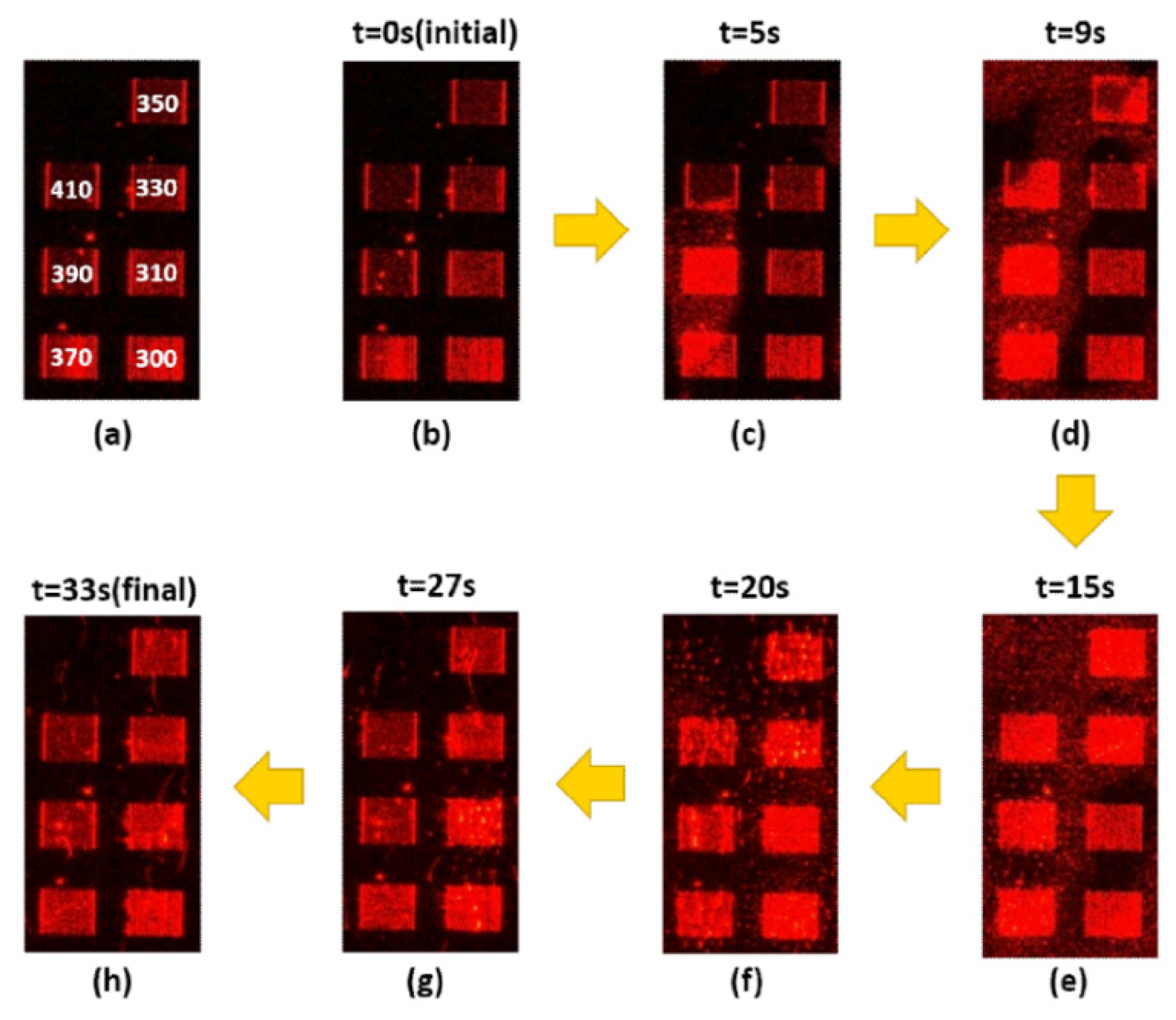

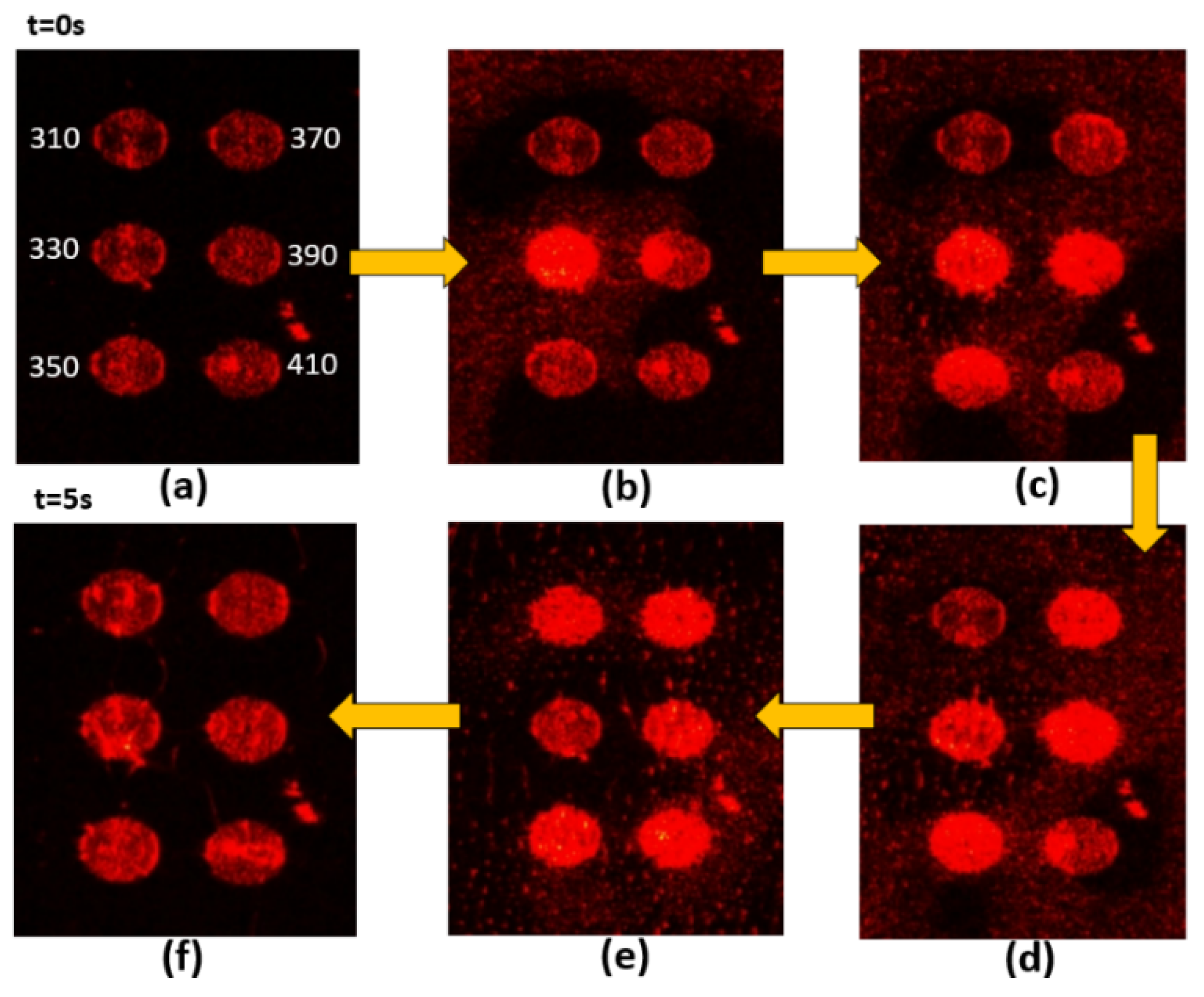
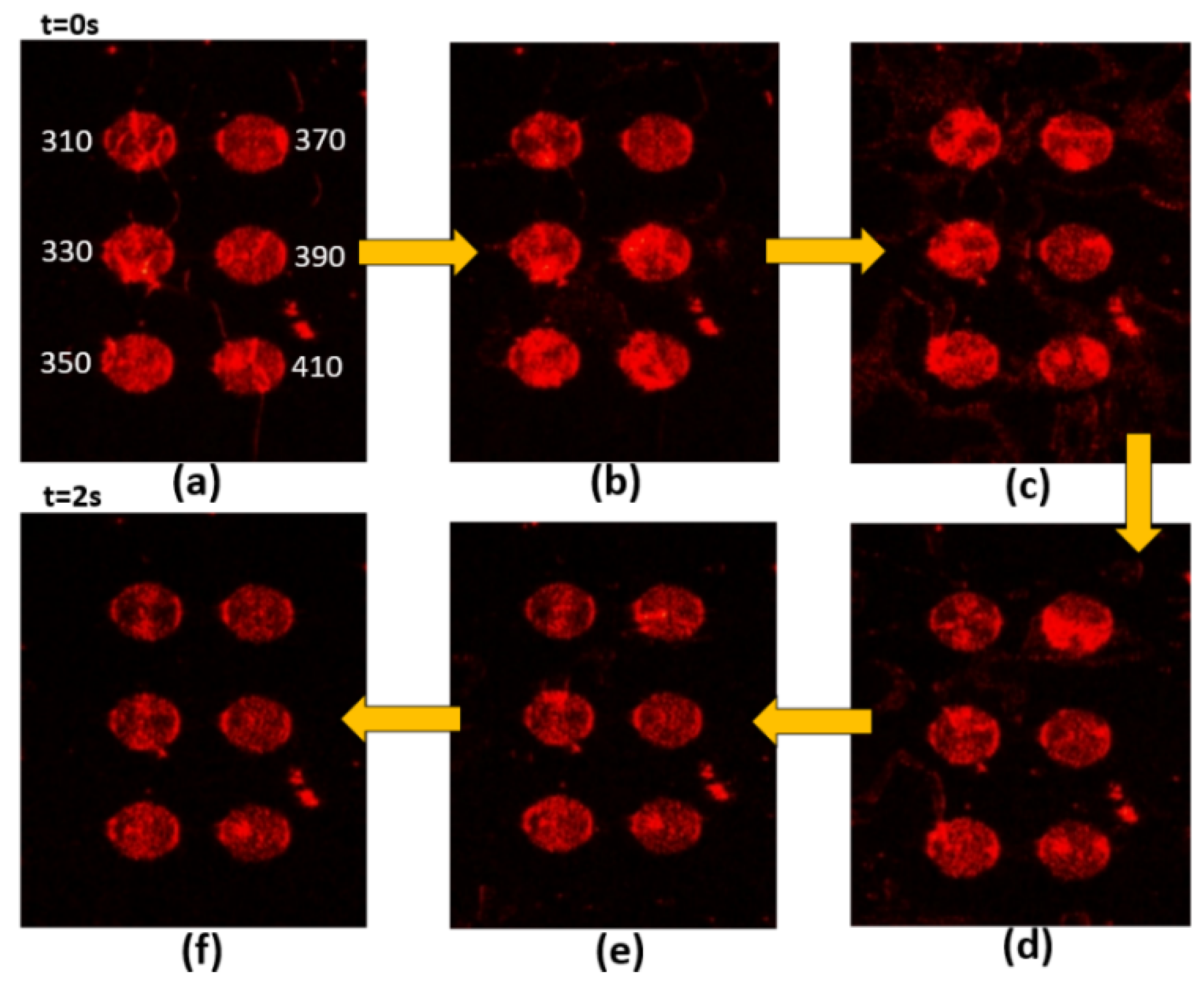
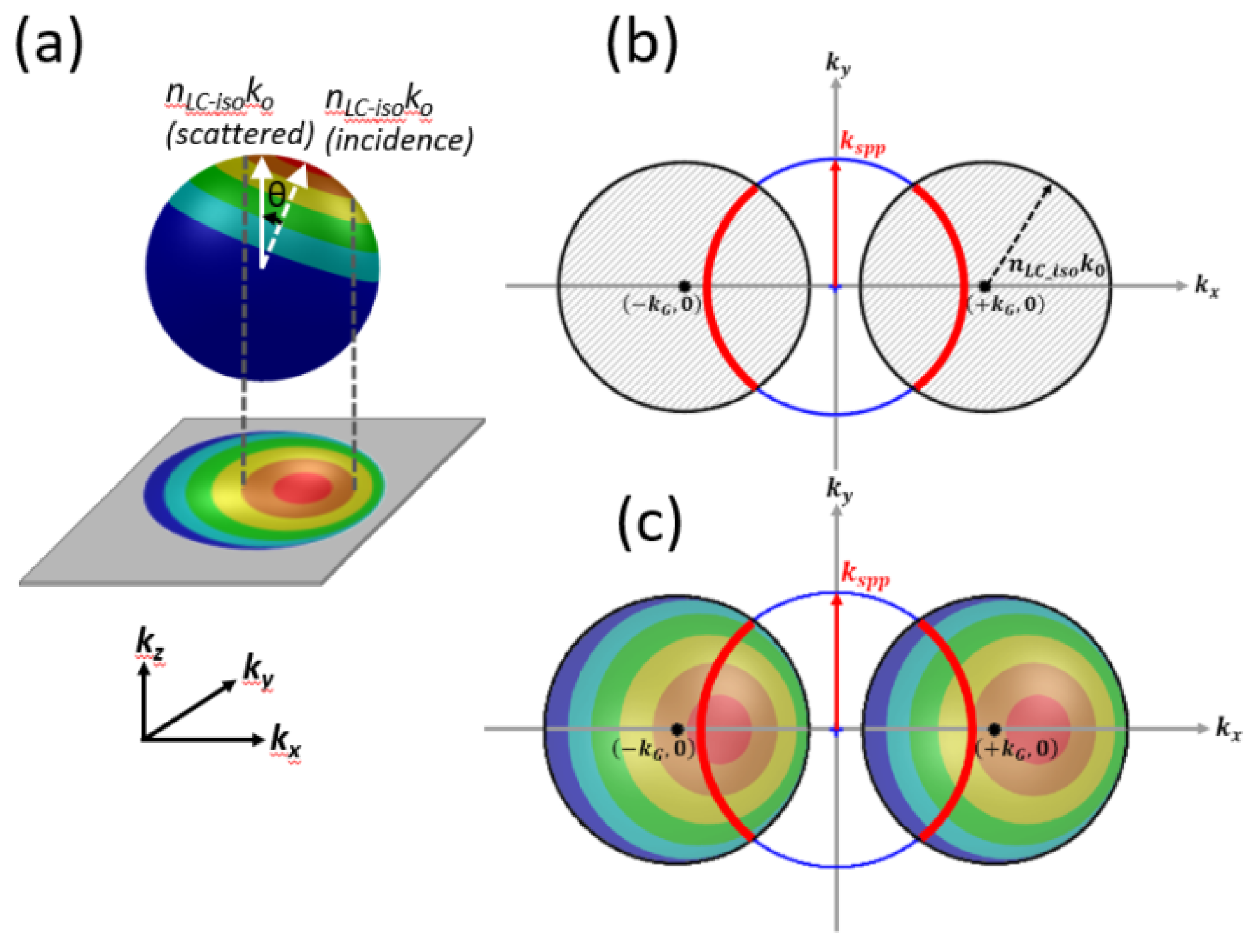

| Aluminum | Database (at λ = 632 nm) | Real(kspp)/ko | Imag(kspp)/ko |
| Data1 | Rakić (1995) | 1.625 | 0.014 |
| Data2 | Rakić: Brendel-Bormann model (1998) | 1.628 | 0.013 |
| Data3 | McPeak (2015) | 1.635 | 0.016 |
| Nickel | Database (at λ = 632 nm) | Real(kspp)/ko | Imag(kspp)/ko |
| Data1 | Johnson and Christy (1974) | 1.649 | 0.085 |
| Data2 | Rakić: Brendel-Bormann model (1998) | 1.647 | 0.108 |
| Data3 | Werner: DFT calculations (2009) | 1.632 | 0.071 |
© 2020 by the authors. Licensee MDPI, Basel, Switzerland. This article is an open access article distributed under the terms and conditions of the Creative Commons Attribution (CC BY) license (http://creativecommons.org/licenses/by/4.0/).
Share and Cite
Dong, G.-T.; Wang, C.-T.; Hung, Y.-J. Spatially Broadband Coupled-Surface Plasmon Wave Assisted Transmission Effect in Azo-Dye-Doped Liquid Crystal Cell. Nanomaterials 2020, 10, 1357. https://doi.org/10.3390/nano10071357
Dong G-T, Wang C-T, Hung Y-J. Spatially Broadband Coupled-Surface Plasmon Wave Assisted Transmission Effect in Azo-Dye-Doped Liquid Crystal Cell. Nanomaterials. 2020; 10(7):1357. https://doi.org/10.3390/nano10071357
Chicago/Turabian StyleDong, Guan-Ting, Chun-Ta Wang, and Yu-Ju Hung. 2020. "Spatially Broadband Coupled-Surface Plasmon Wave Assisted Transmission Effect in Azo-Dye-Doped Liquid Crystal Cell" Nanomaterials 10, no. 7: 1357. https://doi.org/10.3390/nano10071357
APA StyleDong, G.-T., Wang, C.-T., & Hung, Y.-J. (2020). Spatially Broadband Coupled-Surface Plasmon Wave Assisted Transmission Effect in Azo-Dye-Doped Liquid Crystal Cell. Nanomaterials, 10(7), 1357. https://doi.org/10.3390/nano10071357




